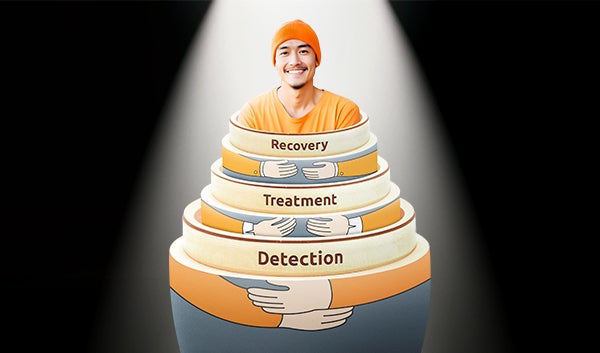New Cancer Therapies: Planning Ahead
Singapore may be a small island nation but we enjoy great life expectancy, among the highest in the world1. However, living longer comes hand in hand with a higher likelihood that we will face more years living with some form of disease, including cancer2. In fact, the number of cancer cases have increased by 17% since 20103. Thankfully, improvements in cancer treatments have significantly improved survival rates4.
Among these recent developments in cancer therapy are cell, tissue and gene therapy – at this time, Singapore is the first in Southeast Asia to offer these therapies, which offer a beacon of hope for patients who have found other forms of cancer treatment unsuccessful5.
What is cell, tissue and gene therapy?
Conventional cancer treatment involves surgery to remove the tumour, combined with the use of strong drugs known as chemotherapy and/or radiotherapy which is the use of radiation, to destroy any remaining cancer cells and prevent the cancer from returning6.
Cell, tissue and gene therapy work differently, using human or animal cells or tissue instead of drugs or chemicals7. As a therapeutic category, it is relatively new and offers many possibilities for treating a wide range of conditions, including cancer, by repairing or replacing damaged tissues or faulty genes8,9.
For example, problems with the p53 gene have been linked to several types of cancer, hence fixing this gene to restore its proper function could help destroy the cancer10. Advancements in gene therapy could also allow doctors to prevent further growth of the cancerous cells, starve them or cause them to die11. To-date, breakthroughs in gene therapy have enabled doctors to treat leukaemia more effectively12, which accounts for 30 to 40% of all childhood cancers in Singapore13.
Leukaemia is a cancer of the white blood cells that starts in the bone marrow, creating abnormal white blood cells that spread to the blood, lymph nodes and other organs. While healthy white blood cells help to protect the body against disease, leukaemia makes them defective and also prevents the bone marrow from its normal functions of producing red blood cells, white blood cells and platelets. There is no known way to prevent it as most cases develop from non-inherited gene mutations in growing blood cells14.
Other types of cancer that may be treated using cell, tissue and gene therapy include lymphoma, which is the fifth most common cancer in males and sixth in females in Singapore15.
However, while cell, tissue and gene therapy is very promising, each patient’s case is unique and only a doctor can provide advice on the most appropriate form of therapy, and its associated risks and benefits.
Prudent planning for the future
As the risk for developing cancer increases with age and our increasing life expectancy, it is only wise to plan ahead, against the possible need to finance treatment for chronic conditions like cancer.
This is especially relevant with the recent adjustments to the Ministry of Health’s cancer insurance model to limit claims and eligibility for cancer therapy16 in an effort to reign in rising government spending on cancer drugs, which has been growing at a compound annual growth rate of 20% between 2017 and 202017.
Overall, the cost of cancer therapy varies greatly according to the stage and type of cancer, type of therapy, duration of treatment, and many other factors. By some estimates, traditional cancer treatments cost several hundred dollars a month while newer forms of treatment can cost in excess of S$5,000 a month18.
The Ministry of Health offers the following total cost estimates for treatment of cancer of the blood and lymph nodes (without severe complications)19:
| Public Hospitals/Centres (subsidised) | Public Hospitals/Centres (unsubsidised) | Private Hospitals/Centres |
| S$3,393 for Ward B2 | S$8,616 for Ward B1 | S$17,479 for inpatient treatment |
To help you plan for the future and prepare against the possible need for treatment, the Star Secure Pro plan offers comprehensive, life-long coverage. In addition to protection against total and permanent disability and terminal illness, the rider, Early Life Accelarator, also incorporates a Special Therapy Benefit20 that applies to those receiving cell, tissue and gene therapy for the treatment of catastrophic cancers (such as leukaemia, lymphoma and stage 4 malignant tumours).
Star Secure Pro also caters to different financial situations, allowing you to choose your desired level of protection and duration of premiums, with the option to supplement your coverage with riders for additional protection.
Another plan to consider is Complete Critical Protect, a critical illness insurance plan that provides continuous protection against dread disease from diagnosis to recovery. Its Therapy Support Benefit21 offers 20% of the sum assured for those undergoing cell, tissue or gene therapy or proton beam therapy.
Uncertain about where to begin? Connect with us to explore the plans in depth and determine which ones best fit your insurance needs and budget.
1Channel News Asia, 26 November 2020. “Singaporeans' life expectancy among highest in the world: Public sector report”, https://www.channelnewsasia.com/singapore/public-sector-report-life-expectancy-spor-covid-19-570646
2 Today, 21 June 2019. “Singaporeans living longer but spending more time in ill health: Study”, https://www.todayonline.com/singapore/singaporeans-living-longer-spending-greater-proportion-time-ill-health-study
3 HealthXchange.sg. “Sharp rise in number diagnosed with cancer”, https://www.healthxchange.sg/news/sharp-rise-in-number-diagnosed-with-cancer
4 Channel News Asia, 18 February 2022. “Controlling Cancer like a Chronic Disease,” https://www.channelnewsasia.com/health-matters/controlling-cancer-chronic-disease-2488591
5 Channel News Asia, 24 April 2021. “'Breakthrough’ therapy for the most common type of leukaemia among children approved in Singapore”, https://www.channelnewsasia.com/singapore/new-therapy-for-leukaemia-among-children-kymriah-blood-cancer-217446
6 Mayo Clinic, 25 May 2022. Cancer treatment, https://www.mayoclinic.org/tests-procedures/cancer-treatment/about/pac-20393344
7 SingHealth, 8 October 2021. “Cell Therapy: No Longer Science Fiction but a Growing Clinical Reality”, https://www.singhealth.com.sg/news/defining-med/cell-therapy-overview
8 Association for the Advancement of Blood & Biotherapies. “Facts About Cellular Therapies”, https://www.aabb.org/news-resources/resources/cellular-therapies/facts-about-cellular-therapies
9 US Food and Drug Administration. “How Gene Therapy Can Cure or Treat Diseases”, https://www.fda.gov/consumers/consumer-updates/how-gene-therapy-can-cure-or-treat-diseases
10 Mayo Clinic. 29 December 2017. “Gene therapy”, https://www.mayoclinic.org/tests-procedures/gene-therapy/about/pac-20384619
11 OncoLink. “What is Gene Therapy?”, https://www.oncolink.org/cancer-treatment/gene-immunotherapy/what-is-gene-therapy
12 Boston Children’s Hospital. “After decades of evolution, gene therapy arrives”, https://answers.childrenshospital.org/gene-therapy-history/
13 National University Hospital, 6 September 2022. “Childhood Leukaemia”, https://www.nuh.com.sg/Health-Information/Diseases-Conditions/Pages/Childhood-Leukaemia.aspx.
14 National University Hospital, 6 September 2022. “Childhood Leukaemia”, https://www.nuh.com.sg/Health-Information/Diseases-Conditions/Pages/Childhood-Leukaemia.aspx.
15 SingHealth. “Lymphoma”, https://www.singhealth.com.sg/patient-care/conditions-treatments/lymphoma
16 The Straits Times, 19 August 2022. “New chemotherapy and cancer treatment cost calculator launched to help estimate expenses”, https://www.straitstimes.com/singapore/new-cancer-treatment-calculator-simplifies-cost-estimates-for-patients-amid-insurance-changes
17 The Straits Times, 18 August 2021. “Why S'pore spends so much on cancer treatment and how MediShield Life changes aim to tackle this”, https://www.straitstimes.com/singapore/health/why-singapore-spends-so-much-on-cancer-treatment-and-how-changes-to-medishield-life
18 The Straits Times, 18 August 2021. “Why S'pore spends so much on cancer treatment and how MediShield Life changes aim to tackle this”, https://www.straitstimes.com/singapore/health/why-singapore-spends-so-much-on-cancer-treatment-and-how-changes-to-medishield-life
19 Ministry of Health. Fee Benchmarks and Bill Amount Information: Blood, Cancer of the Blood and Lymph Nodes Without Very Severe Complications, https://www.moh.gov.sg/cost-financing/fee-benchmarks-and-bill-amount-information/Details/R61B--0
20 We will only pay this benefit if the insured is diagnosed with catastrophic cancer which require the insured to undergo cell, tissue and gene therapy. For policies we have issued that have Special Therapy Benefit, we will pay no more than S$50,000 (excluding bonuses) for each insured (no matter how many policies we have issued to cover each insured). We will not pay this benefit if the insured suffered symptoms of, was investigated for, or was diagnosed with the disease any time before or within 90 days from the cover start date. We will only pay this benefit if the basic policy has not ended
21 At most, Income Insurance will pay the Therapy Support Benefit two times and only one payout for each therapy, less any amount the policyholder owes Income Insurance. The entire treatment for each therapy must be done in Singapore. Income Insurance will pay no more than $50,000 for each therapy listed (no matter how many policies Income Insurance has issued and paid to cover each insured). Income Insurance will not pay this benefit if the insured suffered symptoms of, was investigated for, or was diagnosed with any condition which requires therapy under this benefit any time before or within 90 days from the cover start date, whichever is earliest.
The policy will continue even if this benefit ends.
This article is meant purely for informational purposes and should not be relied upon as financial advice. The precise terms, conditions and exclusions of any Income Insurance products mentioned are specified in their respective policy contracts. For customised advice to suit your specific needs, consult an Income Insurance advisor. This advertisement has not been reviewed by the Monetary Authority of Singapore.
These policies are protected under the Policy Owners’ Protection Scheme which is administered by the Singapore Deposit Insurance Corporation (SDIC). Coverage for your policy is automatic and no further action is required from you. For more information on the types of benefits that are covered under the scheme as well as the limits of coverage, where applicable, please contact Income Insurance or visit the GIA/LIA or SDIC websites (www.gia.org.sg or www.lia.org.sg or www.sdic.org. sg).






